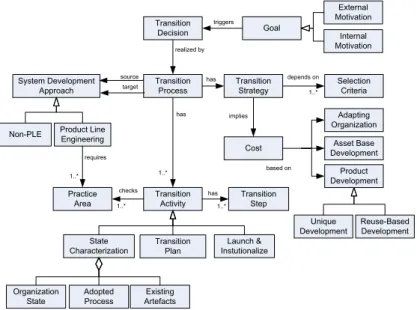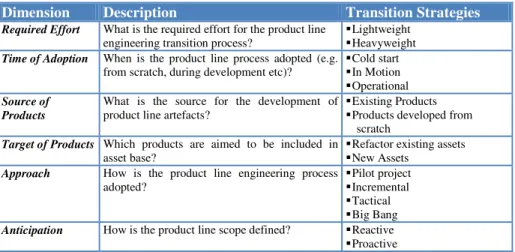J. Bosch and J. Lee (Eds.): SPLC 2010, LNCS 6287, pp. 461–465, 2010. © Springer-Verlag Berlin Heidelberg 2010
Multidimensional Classification Approach for Defining
Product Line Engineering Transition Strategies
Bedir Tekinerdogan1, Eray Tüzün2, and Ediz Şaykol2
1
Bilkent University, Department of Computer Engineering, 06800 Bilkent Ankara, Turkey
bedir@cs.bilkent.edu.tr
2
Havelsan A.Ş., Peace Eagle Program, Research and Development Team, ODTU Teknokent, 06531, Ankara, Turkey
{etuzun,esaykol}@havelsan.com.tr
Abstract. It is generally acknowledged that the transitioning process to a product line engineering approach is not trivial and as such requires a planned transition process. Different classifications of transition strategies have been proposed in the literature. It appears that these classification schemes are usually based on a single dimension. However, the adoption of a transition strategy is dependent on various criteria and very often it is not easy to characterize the required transition strategy. An appropriate characterization of the transition strategy is important for carrying out the right transition activities and steps to provide an operational product line engineering approach. In this paper, we first provide a conceptual model for defining the concepts related to transition strategies and then propose a multi-dimensional classification approach that aims to provide a more complete view on transition strategies. Keywords: software product line engineering, product line transition strategy, multi-dimensional classification.
1 Introduction
It is generally acknowledged that transitioning to a product line engineering approach needs to be performed carefully to avoid failures and mitigate risks that are inherent to product line engineering and the transitioning process [7][9]. Likewise, the product line engineering community has proposed different transition strategies that aim to support the transition process and as such help to define a proper product line engineering approach for the organization. The selection of a transition strategy is largely driven by the specific business goals of the organization. To achieve these goals the organization needs to select one or more transition strategies that help to settle and carry out a product line engineering approach. Despite the benefits of each of these approaches we can observe that the transition strategies, as described in the literature, are classified differently, and likewise include somehow different transition strategies. Very often, it appears that the classification of the transition strategies is based on a single dimension. In reality, it seems that it is usually not easy to select a transition strategy based on the characterization of the existing, often complex state of
a non-product line engineering approach. Yet, an appropriate characterization of the transition strategy is important for the selection of the right transition strategy and the healthy execution of the transition process.
In this paper we first provide a conceptual model that defines the key concepts for the transition process. The conceptual model represents a general model that can be used to instantiate multiple transition processes. Based on the conceptual model and the existing transition strategies, we propose a multi-dimensional classification approach for defining the space of transition strategies. The dimensions in this classification approach represent the criteria for classification while the values on the dimensions represent the separate transition strategies. The novel classification approach is complementary to existing approaches, reuses existing classification dimensions and proposes new classification dimensions to characterize a transition strategy. We believe that the analysis and the survey can support both practitioners and researchers. Practitioners will be supported by providing the first guidance in understanding the transition process and defining a more accurate transition strategy. For researchers the study may provide better insight in the current approaches and, if necessary, define new classification dimensions or new transition strategies.
The remainder of the paper is organized as follows. In Section 2 we provide the conceptual model for a transition strategy. Section 3 proposes the multidimensional classification approach for product line transition strategies. Finally, Section 4 concludes the paper.
2 Conceptual Model
The methodology and roadmap for switching to product line engineering from a traditional way of software development is defined as adoption or transition, and a plan of actions during this process is called the transition strategy [9]. Based on the existing literature [1][2][3][4][5][8][9][10] we have defined a conceptual model related to transition strategies in software product line engineering. The model is depicted in Figure 1. The rectangles represent concepts; the relations define association and inheritance relations similar to UML. In principle this conceptual model aims to represent the different transition strategies which can be found in the literature. A particular transition approach should be considered as an instance of this conceptual model.
3 Multidimensional Classification
An extensive review of the literature shows that there is actually no clear consensus yet on the transition strategies and the proposed transition strategies are defined from a particular standpoint only. Although the literature represents different classification mechanisms, based on the model as depicted in Figure 2 we can define the design space as a combination of multiple classification mechanisms or dimensions. Each dimension will have its own values or transition strategies. To identify the dimensions (classifications), initially we looked at the literature (domain) of the transition strategies. Unfortunately, deriving orthogonal dimensions from the domain is not as
Transition Process Non-PLE Transition Decision Transition Activity System Development Approach Goal External Motivation Internal Motivation Product Line Engineering Cost triggers has implies Adapting Organization Asset Base Development Product Development source target based on Unique Development Reuse-Based Development State Characterization Launch & Instutionalize Transition Plan Transition Strategy realized by has Practice Area has 1..* 1..* Organization State Adopted Process Existing Artefacts Transition Step checks requires 1..* 1..* Selection Criteria depends on 1..*
Fig. 1. Conceptual Model for Transition Strategies in Software Product Line Engineering easy as it might look. The reason for this is that the existing classification approaches do not only use different dimensions and dimension names, but these also seem to overlap with each other. Very often the dimension is not explicitly defined but directly the transition strategies are listed.
Transition
Strategy Space Dimension
has Transition Process has Transition Strategy has Selection Criteria determines 1..* 1..* Organization defines applies adopts 1..* 1..* 1..*
Fig. 2. Conceptual Model for Product Line Classification Schemes
Nevertheless, to illustrate the idea we have abstracted from the dimensions in the literature and defined and aligned a set of dimensions that we think are orthogonal and relevant for defining a space of transition strategies. These dimensions are defined in Table 1.
It should be noted here that Table 1 is a proposal for dimensions and as such we do not pretend that the dimensions are complete or fixed. New dimensions may be added to the list or the existing dimensions might be removed. Given the dimensions in Table 1, an organization can define its own transition strategy space that is spanned by a selected set of dimensions in the table. A coordinate in the space typically represents
Table 1. Description of multiple dimensions for classification of transition strategies
Dimension Description Transition Strategies
Required Effort What is the required effort for the product line engineering transition process?
Lightweight Heavyweight Time of Adoption When is the product line process adopted (e.g.
from scratch, during development etc)?
Cold start In Motion Operational Source of
Products
What is the source for the development of product line artefacts?
Existing Products Products developed from
scratch Target of Products Which products are aimed to be included in
asset base?
Refactor existing assets New Assets
Approach How is the product line engineering process adopted?
Pilot project Incremental Tactical Big Bang Anticipation How is the product line scope defined? Reactive
Proactive
the customized strategy that is defined from multiple perspectives (i.e. dimensions). As such, a transition strategy in this view is defined as a vector consisting of multiple values. For example, based on Table 1 we might derive the following transition strategy:
Transition Strategy Alternative = { (Required Effort.Lightweight,
Time of Adoption.Cold Start, Source of Products.Products from Scratch, Target of Products. New Assets, Approach.Pilot Project, Anticipation.Proactive) }
Once the transition strategy space is defined, transition strategies can be selected. Based on a reflection and abstraction from the existing literature, in Table 2 we have compiled a set of selection criteria that we think are relevant for determining the transition strategy. An organization may derive a transition strategy by defining values for selection criteria. The nature and the exact number of selection criteria will be unique for each organization. In principle these selection criteria queries will reduce the transition space. To identify the feasible transition strategy for an organization sufficient selection criteria and their values must be defined.
Table 2. Description of selection criteria for adoption strategies
Selection Criteria Description Values
Maturity of the Organization
Is there a well-defined structure, are the communication channels well-defined, etc?
Low, Medium, High Maturity of the
application domain
How stable is the application domain? Low, Medium, High Maturity of the products What is the quality of the products? How
mature are the products?
Low, Medium, High Maturity of practice
areas
What is the degree of knowledge in the practice areas?
Low, Medium, High Predictability of the
product requirements
How easy is it to predict changes in the product requirements?
Not predictable, Changing, Fixed
Business goals What are the high level costs that are of key interests to the business?
Time-to-market, Quality, Low Cost
4 Conclusions
In this paper, we have proposed a multi-dimensional classification approach that aims to provide a complementary and broader view on transition strategies. We have provided a conceptual model that summarizes the existing transition strategies. Based on the conceptual model and the study to existing transition strategies we have proposed a multi-dimensional classification approach for organizing the transition strategies. In our future work we aim to formalize the multidimensional approach and provide tool support for defining, selecting and prioritizing the dimensions and the selection criteria.
References
[1] Bayer, J., et al.: PuLSE: A Methodology to Develop Software Product Lines. In: Proc. Symposium Software Reusability (SSR 1999), pp. 122–131. ACM Press, New York (1999)
[2] Boeckle, G., Bermejo, J., Knauber, P., Krueger, C., Leite, J., van der Linden, F., Northrop, L., Stark, M., Weiss, D.: Adopting and institutionalizing a product line culture. In: Chastek, G.J. (ed.) SPLC 2002. LNCS, vol. 2379, p. 49. Springer, Heidelberg (2002) [3] Bosch, J.: Maturity and Evolution in Software Product Lines: Approaches, Artefacts and
Organization. In: Chastek, G.J. (ed.) SPLC 2002. LNCS, vol. 2379, pp. 257–271. Springer, Heidelberg (2002)
[4] Bühne, S., Chastek, G., Kakola, T., Knauber, P., Northrop, L., Thiel, S.: Exploring the context of product line adoption. In: van der Linden, F.J. (ed.) PFE 2003. LNCS, vol. 3014, pp. 19–31. Springer, Heidelberg (2004)
[5] Clements, P.C., Northrop, L.: Software Product Lines: Practices and Patterns. Addison-Wesley, Boston (2002)
[6] Clements, P.C., Jones, L.G., McGregor, J.D., Northrop, L.M.: Getting there from here: A Roadmap for Software Product Line Adoption. CACM 49(12) (December 2006)
[7] IEEE Software, Special Issue of Software Product Lines (July/August 2002)
[8] Krueger, C.W.: New Methods in Software Product Line Development. In: Proc. of 10th Software Product Line Conference, BigLever Software, Austin, TX (2006)
[9] Pohl, K., Böckle, G., van der Linden, F.: Software Product Line Engineering – Foundations, Principles, and Techniques. Springer, Heidelberg (2005)
[10] Schmid, K., Verlage, M.: The Economic Impact of Product Line Adoption and Evolution. IEEE Software 19(4), 50–57 (2002)

